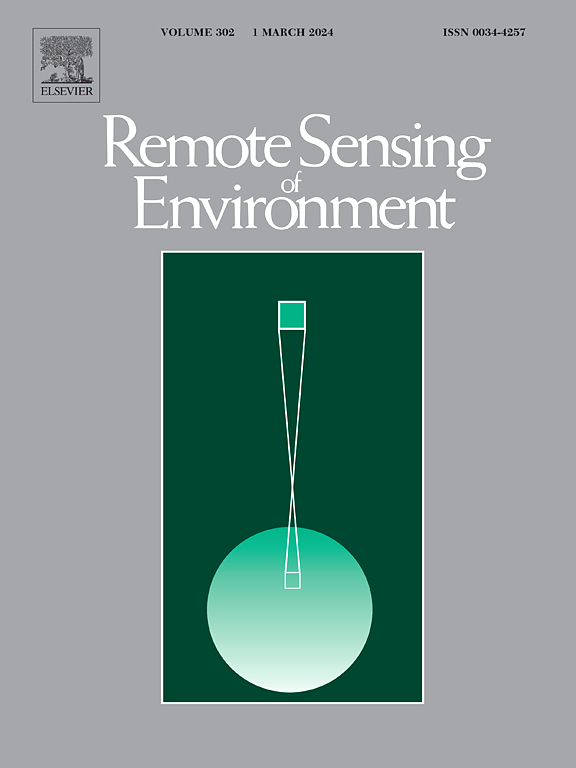基于实体的图像分析:利用陆地卫星图像绘制农村居民点的新策略
IF 11.1
1区 地球科学
Q1 ENVIRONMENTAL SCIENCES
引用次数: 0
摘要
利用中分辨率卫星图像(如Landsat数据)准确、及时地绘制农村居民点地图,对于评估农村基础设施、估算生态服务价值、评估农村人口生活质量和促进农村可持续发展至关重要。目前的制图技术,包括基于像素和基于物体的分类,主要侧重于识别人工表面,往往无法捕捉农村住区的完整空间足迹。这些聚落由不同的土地覆盖元素组成,如房屋、道路、农业建筑、池塘、公园和林地,这些元素共同构成了具有鲜明地方特色的实体。为了解决这一限制,我们引入了一种新的分类策略:基于实体的图像分析(EBIA)。EBIA受人类视觉感知认知原理的启发,将相关的土地覆盖元素分组,并将聚落与其背景区分开来。EBIA的关键创新在于它能够将语义特征融入乡村聚落,将像素级土地覆盖分类结果(第一阶段)转化为实体级聚落制图结果(第二阶段)。研究结果表明,EBIA有效地绘制了乡村聚落实体的综合足迹,在全球选择的五个试验区中获得了0.79至0.88的F1分数。此外,EBIA可用于利用长期陆地卫星图像监测农村住区的变化。作为一种新的分类策略,EBIA具有映射其他地理实体的潜力。本文章由计算机程序翻译,如有差异,请以英文原文为准。
Entity-based image analysis: A new strategy to map rural settlements from Landsat images
Accurate and timely mapping of rural settlements using medium-resolution satellite imagery, such as Landsat data, is crucial for evaluating rural infrastructure, estimating ecological service values, assessing the quality of life for rural populations, and promoting sustainable rural development. Current mapping techniques, including pixel-based and object-based classifications, primarily focus on identifying artificial surfaces, often failing to capture the complete spatial footprint of rural settlements. These settlements consist of diverse land cover elements, such as houses, roads, agricultural buildings, ponds, parks, and woodlands, which together form entities with distinct local characteristics. To address this limitation, we introduce a novel classification strategy: Entity-Based Image Analysis (EBIA). Inspired by cognitive principles of human visual perception, EBIA groups related land cover elements and differentiates settlements from their background. The key innovation of EBIA lies in its ability to incorporate semantic features within rural settlements, transforming pixel-level land cover classification results (Phase 1) into entity-level settlement mapping results (Phase 2). Our results demonstrate that EBIA effectively maps the comprehensive footprint of rural settlement entities, achieving F1 scores ranging from 0.79 to 0.88 across five globally selected experimental areas. Furthermore, EBIA can be utilized to monitor changes in rural settlements using long-term Landsat imagery. As a new classification strategy, EBIA holds potential for mapping other geographic entities.
求助全文
通过发布文献求助,成功后即可免费获取论文全文。
去求助
来源期刊

Remote Sensing of Environment
环境科学-成像科学与照相技术
CiteScore
25.10
自引率
8.90%
发文量
455
审稿时长
53 days
期刊介绍:
Remote Sensing of Environment (RSE) serves the Earth observation community by disseminating results on the theory, science, applications, and technology that contribute to advancing the field of remote sensing. With a thoroughly interdisciplinary approach, RSE encompasses terrestrial, oceanic, and atmospheric sensing.
The journal emphasizes biophysical and quantitative approaches to remote sensing at local to global scales, covering a diverse range of applications and techniques.
RSE serves as a vital platform for the exchange of knowledge and advancements in the dynamic field of remote sensing.
 求助内容:
求助内容: 应助结果提醒方式:
应助结果提醒方式:


